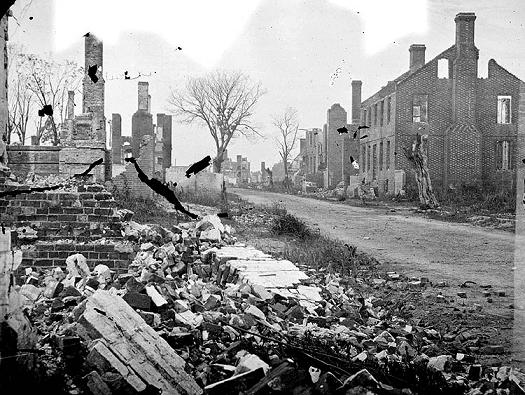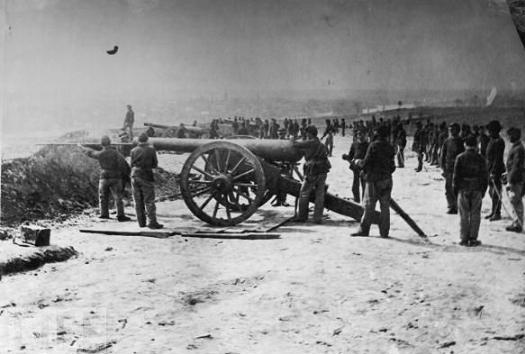
Last week I posted some excerpts from the U.S. Government’s 1904-1905 damage claim investigation into two of Fredericksburg’s historic churches. In both interviews, the wartime carnage that was inflicted on each structure at the hands of the Federal army was recounted by residents who witnessed the abuse firsthand. In retrospect, these churches were actually the lucky ones as they were at least left standing. This was due to their usefulness as headquarters, stables and hospitals. The fact that they survived the Civil War with all four walls and a roof intact is remarkable, especially when they stood at ground zero for the first recorded artillery shelling of an American city. Many of the buildings in the blocks surrounding these churches were either demolished by shot and shell, or burned to the ground. Our friends from the NMPS over at the Mysteries and Conundrums blog have posted some excellent photos and insights on the resulting damage from the Battle of Fredericksburg.
As I was prepping some additional material for my wheelchair tour business I came upon several interesting passages in Francis Augustín O'Reilly’s book The Fredericksburg Campaign: Winter War on the Rappahannock. This is my favorite book on the Battle of Fredericksburg and it is serving as a major source for my tour guide’s commentary. One section in particular from the chapter titled “A Scene of Wildest Confusion” struck me. Although the civilian recollections and post-battle photography lead one to believe that the Union’s artillery successfully wreaked havoc on the town, it appears that 100+ guns did little to accomplish their tactical goals. This inevitably allowed Confederate General William Barksdale’s small contingent of troops to hold off the attacking Federals who were attempting to cross the Rappahannock River. Here are some excerpts from Frank’s book that present the Union troop’s perspective on the artillery attack:
Colonel Charles Tompkin’s Federal artillery responded to the Confederates at both the upper and middle pontoon crossings. An artillerist recalled that the guns answered at once with “a most tremendous cannonade upon the city.” Several batteries opened on the buildings where they had spotted Confederate fire. Tompkins coached his batteries to fire in short bursts-three to six shots per gun-and then allow the smoke to dissipate so they could judge the effect. …Hunt’s batteries intensified their effort between 9:30 and 10:00 a.m. A soldier in Seeley’s battery wrote, “We could see the boards and brick fly as the shells went dashing through the buildings which soon began to present a sorry look.” Confederate General Barksdale sent a detachment of the 21st Mississippi to the river, but Miller’s Union battery shredded it before it reached the foot of William Street. A Second Corps staff officer recounted, “It was a magnificent sight to see the bombardment of the sleepy old town, and we expected to see it quickly reduced to ashes.” “Oh! It was terrific!” rejoiced a man in the 50th New York Engineers. “From the time the fire opened until about 11 a.m., it was one continuous roar.” One soldier called the barrage “a spectacle never, never to be forgotten,” and “believed that every shot told.” An infantryman at the upper crossing said, “It was great amusement to us to watch a solid shot tear through a building, beat down a wall, topple over a chimney or root out a nest of sharpshooters.” Each explosion reverberated with an intensity that startled even the Federals. A New Yorker recalled, “The 11th was a day of bombardment such as even soldiers rarely see.” But Tompkins’ gunners lacked the wherewithal to drive the Confederates away. …Some Union commanders became critical as the artillery “did not appear to do much good.” …A member of Zook’s brigade wrote bitterly, “Thursday was spent wasting ammunition from about 100 guns.” …Impatient engineers grumbled, “Our artillery were very inefficient or they could have blown the buildings that sheltered the devils to atoms.”

According to the Fredericksburg/Spotsylvania National Military Park website, the results of the Federal Army’s massive bombardment did not produce the anticipated results:
Burnside now turned to his artillery chief, Brigadier General Henry J. Hunt, and ordered him to blast Fredericksburg into submission with some 150 guns trained on the city from Stafford Heights. Such a barrage would surely dislodge the Confederate infantry and permit completion of the bridges. Shortly after noon, Hunt gave the signal to commence fire. "Rapidly the huge guns vomited forth their terrible shot and shell into every corner and thoroughfare of [Fredericksburg]," remembered an eyewitness. The bombardment continued for nearly two hours, during which 8,000 projectiles rained destruction on Fredericksburg. Then the grand cannonade ceased and the engineers ventured warily to the ends of their unfinished bridges. Suddenly -impossibly - muzzles flashed again from the cobble-strewn streets and more pontoniers tumbled into the cold waters of the Rappahannock.
Without a doubt the civilians of Fredericksburg suffered greatly due to the Battle of Fredericksburg (as well as the three other battles that took place in the region: Chancellorsville, Spotsylvania and The Wilderness). In a piece titled Voices from the Storm: Civilians Endure the Battle of Fredericksburg, Historian John Hennessy writes:
The people of Fredericksburg faced two more years of war – living life on, and sometimes beyond, the northern edge of the Confederacy. War weighed heavily, completely, on the Fredericksburg region. By war’s end, the community had been transformed, physically (more than 80 buildings destroyed – just under 10% of the city), economically (personal wealth dropped by more than 70%), and socially (thousands of slaves seized freedom). The experience left behind bitterness for white residents that took decades to heal. …Today visible scars from the war are few; only a single home in town still bears exterior battle damage.
Although this historic artillery offensive dealt a devastating blow to the skyline of the city, it did little to drive out the Confederate forces tasked with defending the town and postponing their enemy’s pontoon crossing. It would appear that as senseless as the sacrifice of soldiers would be at Marye’s Heights, an equally senseless destruction was levied upon the civilians of Fredericksburg.
Updated: Wednesday, 14 September 2011 9:38 PM EDT
Permalink | Share This Post





